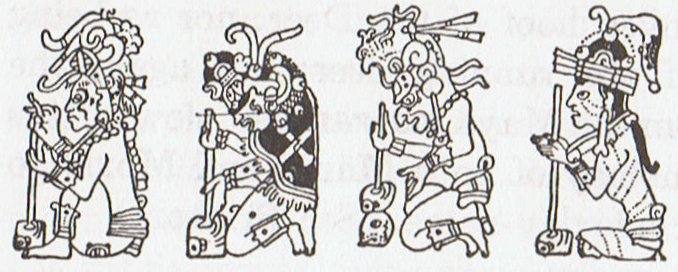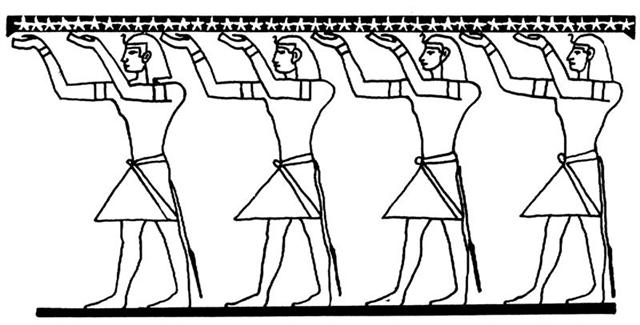... The Mayas called their 4 supporters of the sky Bacab:
'Among the multitude of gods worshipped by these people were four whom they called by the name Bacab. These were, they say, four brothers placed by God when he created the world at its four corners to sustain the heavens lest they fall.' (Diego De Landa according to Graham Hancock in his Fingerprints of the Gods.)
'In the ms. Ritual of the Bacabs, the cantul kuob [the suffix '-ob' indicates plural], cantul bacabob, the four gods, the four bacabs, occur constantly in the incantations, with the four colors, four directions, and their various names and offices.' (William Gates, An Outline Dictionary of Maya Glyphs.)
'... This connects up the present section with the beginning of the 'sacred tonalamatl', at the Spring equinox with the Mayas as with the Mexicans, and in the center of the 364-day year (52 days of which preceded and 52 followed the tonalamatl or tzolkin), ruled by its 91-day quarters by the Four Bacabs, whose quarternary repetition (in the 1820-day period) we have thus verified ...' (Gates, a.a.)
1820 = 20 * 91, i.e. the bacabs circulated 5 times in the 1820-day period, 5 * 364 = 1820, and 7 * 260 also happens to be 1820.
They were ruling the 4 quarters of a 364-day long year, and in the center of this year there were 260 days, the sacred tonalamatl (tzolkin) calendar, which began at spring equinox:
|
52 |
260 = 5 * 52 |
52 |
|
364 = 4 * 91 = 7 * 52 |
'On February 9 the Chorti Ah K'in, 'diviners', begin the agricultural year. Both the 260-day cycle and the solar year are used in setting dates for religious and agricultural ceremonies, especially when those rituals fall at the same time in both calendars.
The ceremony begins when the diviners go to a sacred spring where they choose five stones with the proper shape and color. These stones will mark the five positions of the sacred cosmogram created by the ritual. When the stones are brought back to the ceremonial house, two diviners start the ritual by placing the stones on a table in a careful pattern that reproduces the schematic of the universe. At the same time, helpers under the table replace last year's diagram with the new one. They believe that by placing the cosmic diagram under the base of God at the center of the world they demonstrate that God dominates the universe.
The priests place the stones in a very particular order. First the stone that corresponds to the sun in the eastern, sunrise position of summer solstice is set down; then the stone corresponding to the western, sunset position of the same solstice. This is followed by stones representing the western, sunset position of the winter solstice, then its eastern, sunrise position. Together these four stones form a square. They sit at the four corners of the square just as we saw in the Creation story from the Classic period and in the Popol Vuh. Finally, the center stone is placed to form the ancient five-point sign modern researchers called the quincunx ...
Later on in this series of rituals, the Chorti go through a ceremony they call raising the sky. This ritual takes place at midnight on the twenty-fifth of April and continues each night until the rains arrive. In this ceremony two diviners and their wives sit on benches so that they occupy the corner positions of the cosmic square. They take their seats in the same order as the stones were placed, with the men on the eastern side and the women on the west. The ritual actions of sitting down and lifting upward are done with great precision and care, because they are directly related to the actions done by the gods at Creation. The people represent the gods of the four corners and the clouds that cover the earth. As they rise from their seats, they metaphorically lift the sky. If their lifting motion is uneven, the rains will be irregular and harmful.' (Maya Cosmos)
April 25 is a day of Saturn, just as the 25th of Vaitu Nui when Ira and Makoi set sail. A square of fire (5) is neded in order to create a new 260-day long summer year. Vaitu Nui is the 10th month, the first month beyond summer, and number 10 corresponds to the time when all 9 lives of the great Cat up in the sky have been used up:
|
10 Vaitu nui (April) |
11 Vaitu potu |
12 He Maro |
|
1 He Anakena (July) |
2 Hora iti |
3 Hora nui |
|
4 Tagaroa uri (October) |
5 Ko Ruti |
6 Ko Koró |
|
7 Tua haro (January) |
8 Tehetu'upú |
9 Tarahao |
10 (Vaitu Nui) - 4 (April) = 6 months, and while April north of the equator is the 1st month of the 2nd quarter, April (Vaitu Nui) south of the equator is the 1st month of the 4th quarter.








